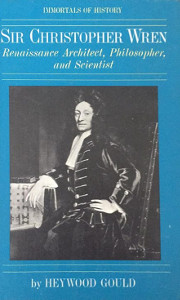Sir Christopher Wren: Renaissance Architect, Philosopher and Scientist

Author:
Heywood Gould
Publication:
1970 by Franklin Watts, Inc
Genre:
Biography, Non-fiction
Series:
Immortals of History ![]() Members Only
Members Only
Pages:
216
Current state:
Basic information has been added for this book.
It is under consideration and will be updated when it is evaluated further.
Book Guide
Search for this book used on:
Sir Christopher Wren is famous as the greatest of English architects. His most acclaimed work, the new Saint Paul's Cathedral, is one of the world's most striking architectural monuments. He was a self-taught architect; yet shortly after he built the chapel of Pembroke College, Cambridge, and the Sheldonian Theatre at Oxford, King Charles II called upon him to redesign the city of London. Later, the king put him in charge of all of Great Britain's royal and government buildings. If he had been nothing but an architect, Wren's place in history would be eminently secure. He was in fact a good deal more. An artist, philosopher, and scientist, Wren characterized the renaissance ideal — a man of brilliant achievement in many diverse fields. He made significant discoveries in geometry, astronomy, anatomy, navigation, and physics, and helped guide the seventeenth-century world into the modern scientific age. In an era of great minds Sir Christopher Wren ranked among the greatest.
From the book
Content Guide
Please sign in to access all of the topics associated with this book and view other books with the same topics.
Please sign in to access the locations this book takes place in and view other books in the same location.
Please sign in to access the time periods this book takes place in and view other books in the same time period.
For information about the lead characters please sign in.
Find This Book
Search for this book used on:


